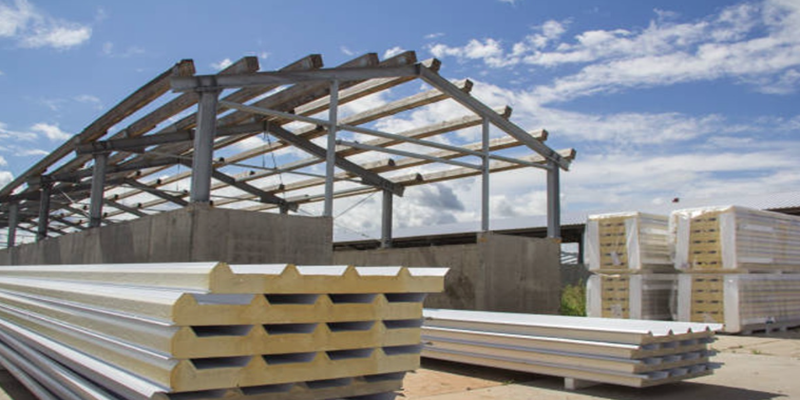The sandwich panel industry relies on high-performance filler materials that provide insulation, fire resistance and structural stability. Polyurethane catalysts (e.g. MXC-5, MXC-8, MXC-41) play a vital role in the production of these materials, helping to achieve faster and more efficient chemical reactions in the foam manufacturing process. The most commonly used materials in sandwich core are inorganic materials such as polyurethane (PUR), polyisocyanurate (PIR), polystyrene, phenolic foam (PF) and rock wool. This paper provides an overview of these materials and how polyurethane catalysts can facilitate their development and application in sandwich panels.
Common Filling Materials for Sandwich Panels
The materials used in sandwich panel cores can be divided into two main categories: foam-based materials and inorganic fiber materials. Each material type offers unique characteristics that make it suitable for specific applications, depending on the thermal, structural, and fire-resistance requirements of the panel.
Foam Materials
1. Polyurethane (PUR) and Polyisocyanurate (PIR):
Polyurethane (PUR) and polyisocyanurate (PIR) are the two most widely used materials in the production of sandwich panels. These materials are produced by the reaction of polyols and isocyanates catalyzed by substances such as MXC-5, MXC-8, and MXC-41. The catalytic activity ensures that the foam expands, cures and bonds effectively within the sandwich plate structure.
- Adhesion and Structural Integrity: One of the main reasons for using PUR/PIR in sandwich panels is its excellent bonding properties. During the foaming process, PUR and PIR adhere well to surface materials such as steel or aluminum skins, thus enhancing the structural integrity of the panel. This characteristic makes these foams a wide choice for laminating lines, as a strong bond is important for stability.
- Improved Fire Resistance: The chemical formulation of PUR/PIR foam has improved over the years, as has its fire resistance, an important characteristic for building applications where strict fire safety regulations need to be met. PIR, in particular, has better fire resistance than PUR, making it a wide choice for high-risk applications.
2. Polystyrene (EPS/XPS):
Polystyrene, including expanded polystyrene (EPS) and extruded polystyrene (XPS), is another foam material used in sandwich panels. While not as commonly used as PUR/PIR, polystyrene offers excellent thermal insulation properties. However, its adhesive properties are not as strong as PUR/PIR, so it may not be suitable for applications that require high structural strength.
- Thermal Insulation: Polystyrene provides excellent thermal insulation at a lower cost compared to other materials, making it a popular choice for cost-sensitive projects. However, it lacks the fire resistance and bonding strength that PUR and PIR offer.
3. Phenolic Foam (PF):
Phenolic foam is relatively new compared to other foam materials and is rarely used in sandwich panel production. However, it offers one significant advantage: superior fire resistance. Phenolic foam has the best fire resistance among foam materials, making it suitable for applications where fire safety is the top priority.
- Fire Resistance: Phenolic foam’s unique chemical composition allows it to withstand higher temperatures without compromising structural integrity. Despite its excellent fire performance, phenolic foam is not as widely used because of its higher cost and limited availability.
Inorganic Fiber Materials
1. Rockwool:
Rockwool, an inorganic fiber material, is used in sandwich panel cores for its excellent fire resistance and sound insulation properties. Unlike foam materials, rockwool is non-combustible, making it an ideal choice for fire-rated applications.
- Thermal and Sound Insulation: Rockwool provides effective thermal insulation, though not as high as some foam materials. Additionally, its fibrous structure helps dampen sound, making it suitable for applications requiring noise reduction.
- Fire Resistance: Rockwool’s main advantage is its non-combustibility. It can withstand extremely high temperatures, making it a preferred choice for buildings that require enhanced fire protection.
The Role of Polyurethane Catalysts in Sandwich Panel Production
Polyurethane catalysts like MXC-5, MXC-8, and MXC-41 are critical to the efficient production of foam materials used in sandwich panels. These catalysts accelerate the chemical reactions between polyols and isocyanates, ensuring that the foam expands uniformly and cures effectively. Without catalysts, the reaction would be slow and incomplete, resulting in poor-quality foam with inadequate bonding and insulation properties.
- Reaction Control: Catalysts control the rate of foam formation, ensuring that the foam expands to fill the entire core of the sandwich panel. They also influence the balance between the blowing and gelation reactions, optimizing the foam’s density and cell structure.
- Environmental Considerations: Many modern polyurethane catalysts are designed to minimize volatile organic compound (VOC) emissions and improve environmental safety. Low-odor, emission-free catalysts, such as MXC-41, contribute to the production of environmentally friendly sandwich panels.
Conclusion
In the production of sandwich panels, selecting the right filling material is crucial to meeting thermal, structural, and fire safety requirements. Foam-based materials like PUR, PIR, polystyrene, and phenolic foam, along with inorganic materials like rockwool, each offer unique advantages. Polyurethane catalysts such as MXC-5, MXC-8, and MXC-41 play a vital role in ensuring the efficient production of high-performance foam materials. These catalysts accelerate the chemical reactions that create the foam, providing improved bonding, thermal insulation, and fire resistance essential for modern construction applications.
Post time: Oct-24-2024


